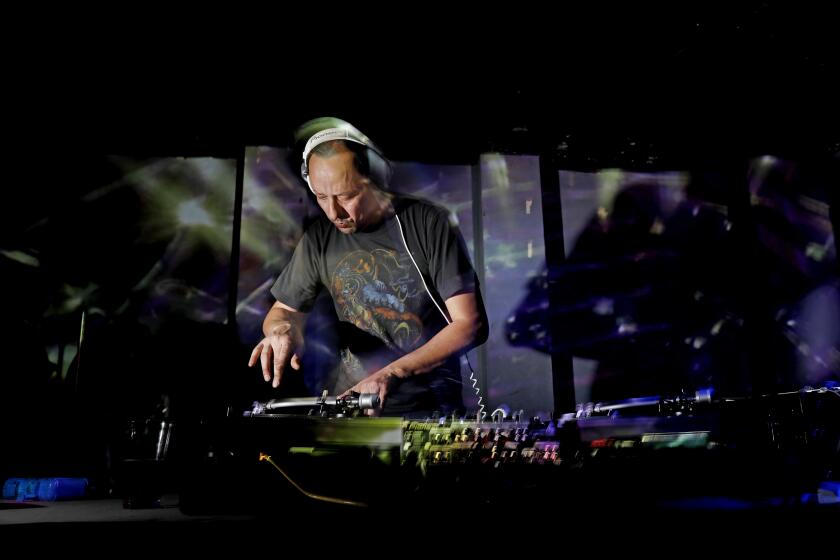Don’t expect a ‘typical’ club experience at techno fixture Carl Craig’s new MOCA exhibit
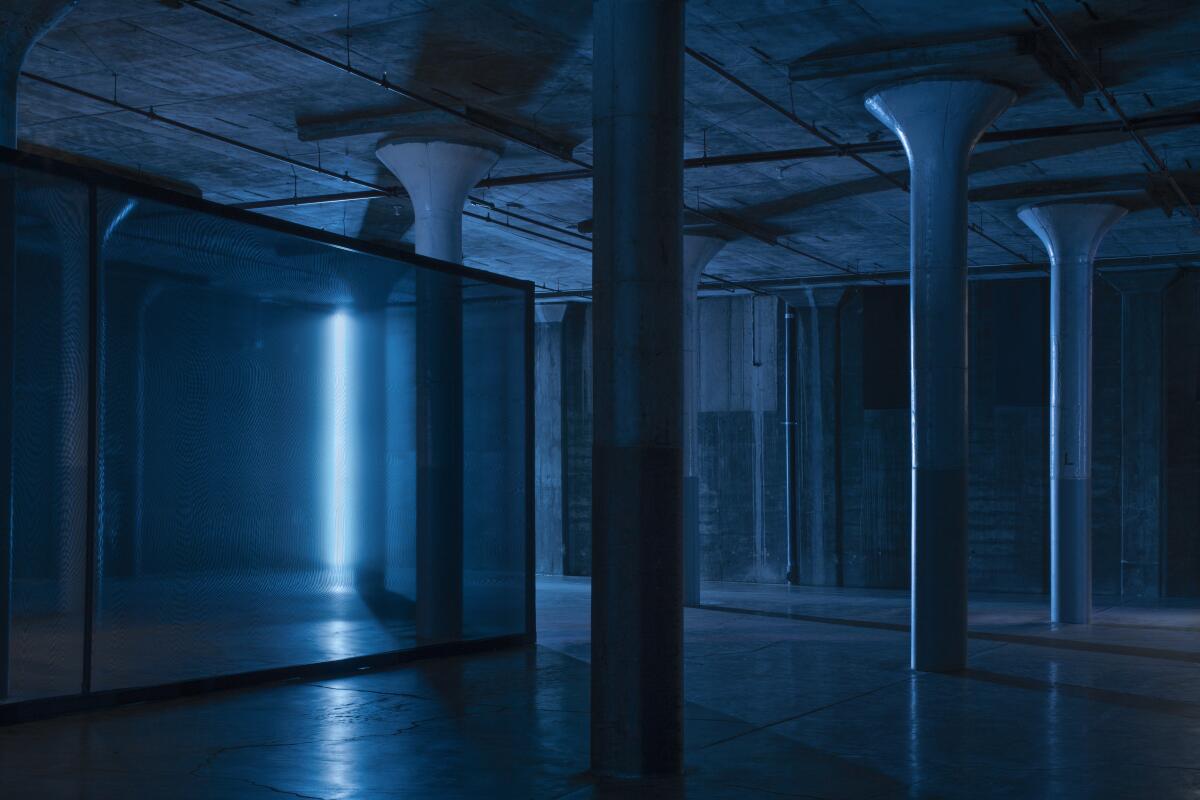
Sharing a dance floor is a unifying experience, whether it’s 30 people in a living room or thousands packed into a club. But no matter how strong that bond, no two sweaty ravers are having the exact same experience.
Music producer and DJ Carl Craig, a trailblazer of the Detroit techno scene, knows that better than anyone. Craig, 53, has spent more than three decades touring the world and is considered a leading figure in the genre’s second wave. For him, a slow weekend involves two performances. More often it’s four, each in a different country.
In “Carl Craig: Party/After-Party,” opening this weekend at the Warehouse at the Geffen Contemporary at MOCA, Craig turns a warehouse party into a museum installation that can outlast him, inviting those who love him and those who think techno is simply oontz oontz to party from his perspective. “‘Party/After-Party’ is a play on words, a play on ideas,” says Craig. The “Party” portion is more literal, a dark warehouse with flashing colorful lights. “After-Party” explores the distinction between how Craig and his audience spend their respective nights once the club closes.
“I want people to understand that it’s not all fun and games,” says Craig. “For me, the after-party is going back to the hotel and living with my tinnitus and trying to sleep and deal with the angst and craziness that’s going through my head. When you’re dealing with tinnitus, you’re wondering, ‘Is this ever going to go away? Am I ever going to hear beyond this ringing in my ears?’”
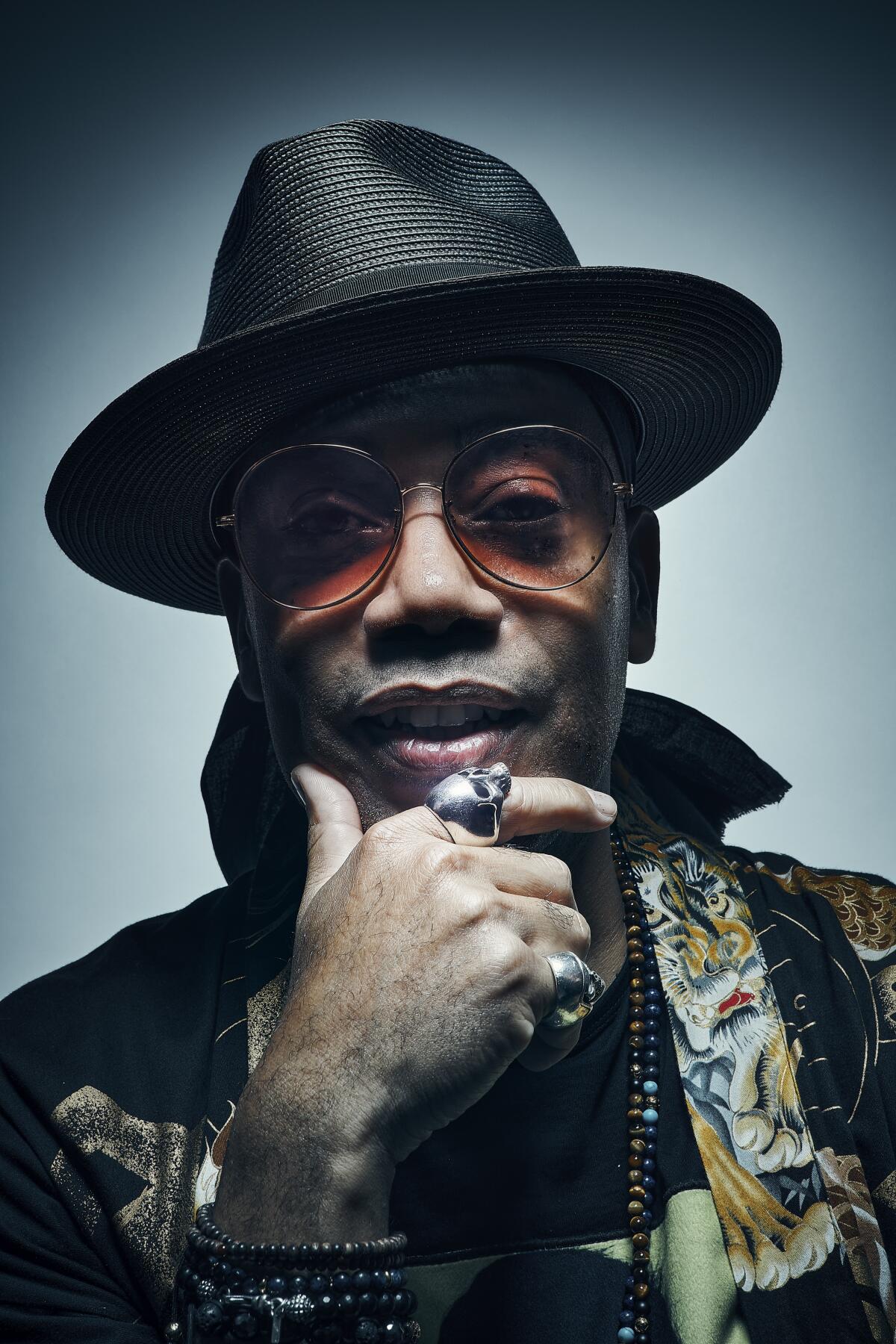
While the term is used by laymen as a catch-all for electronic music, techno has a distinctive sound defined by a “four on the floor” uniform, rhythmic beat pattern. Building off the work of German electronic band Kraftwerk, a group of Detroit-based Black musicians developed and named the burgeoning genre in the late 1970s and early ’80s. Craig drew on his experiences as a musician to create “Party/After-Party.” Commissioned by the Dia Art Foundation, it’s Craig’s first work of visual art and premiered at Dia Beacon in New York.
“Party/After-Party” is rooted in a soundscape that takes viewers on a journey from the party into the after-party. Composed by Craig, the audio ranges from thudding techno beats to white noise to frequencies audible only to listeners of certain age groups. The 30-minute composition runs through software that makes random changes to sonic elements, say the drums or the bassline. Which makes every iteration, like experiencing a DJ set live, slightly different.
While the piece takes place within one warehouse space and does not have timed entry, the transition from the “Party” segment to the “After-Party” is clear in sound and attitude. The warehouse is sprinkled with color-changing LED beams Craig made in collaboration with artist John Torres. Upon entering the space, a translucent scrim wall encourages revelers to contribute their own choreography by splitting the crowd into two sides as they acclimate to the environment. Speakers hung from the ceiling and stacked around the space use sound design to edge viewers toward what associate curator Alex Sloane calls “the sweet spot.”
Standing in the sweet spot, the sound is loud enough to create vibrations in the body. Around the perimeter, different sounds are more audible, sharing secrets between those who opt to take in the party from the edges of the dance floor. The shift from “Party” to “After-Party” is marked by a final shock of natural light, beaming through Warehouse skylights programmed to open in time with the soundscape.
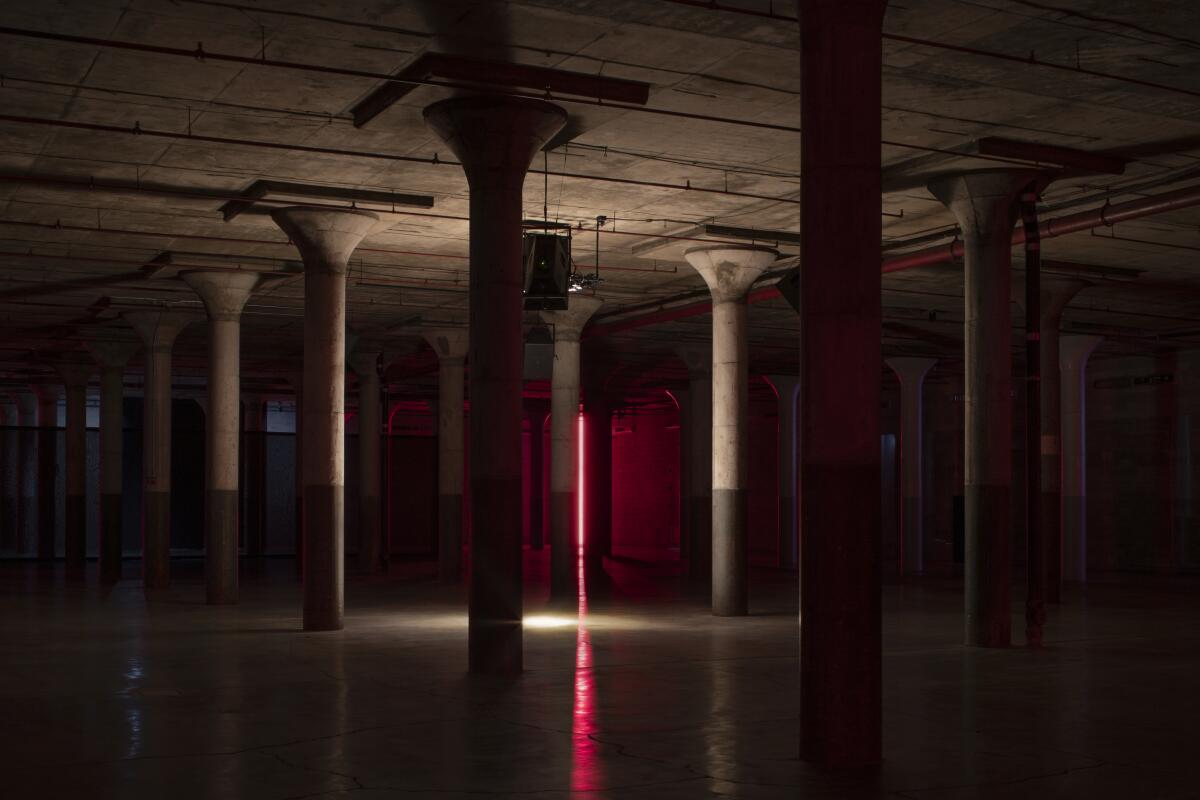
Los Angeles isn’t the most obvious location for “Party/After-Party.” Craig doesn’t have roots here, and the city isn’t usually name-checked as a mecca for the genre. But most cities don’t have museums with a space called Warehouse — one with industrial roots, later used as police storage, begging to be reclaimed as a radical space for experimentation and art. That’s what made MOCA the perfect location.
“The piece is not for every space,” says Sloane. “It’s very site-specific. This location is referencing Detroit warehouse parties, industrial spaces from which techno emerged.”
While the soundscape is the same as was installed at the Dia Beacon, Warehouse’s architecture informed how the piece has evolved to live at MOCA. Instead of Dia’s windows, there are skylights. Those skylights needed to be rigged to open in time with the audio. Changes in light and climate alike affect how the piece is experienced, making every iteration of the piece novel.
With a 2 a.m. curfew and a sprawling layout that often makes club-hopping a trek, Los Angeles is neither Detroit nor Chicago. Many L.A. clubs and venues are owned by ticketing conglomerates Goldenvoice and Live Nation and serve as proving grounds for future festival bookings, often leaving little room for underground artists or scenes to participate in the club ecosystem.
Instead of bringing “Party/After-Party” to a city with decades-old techno clubs, Craig wanted to situate it somewhere less obvious. “L.A. is not known for having a lot of underground clubs. That makes it even more interesting,” he says.
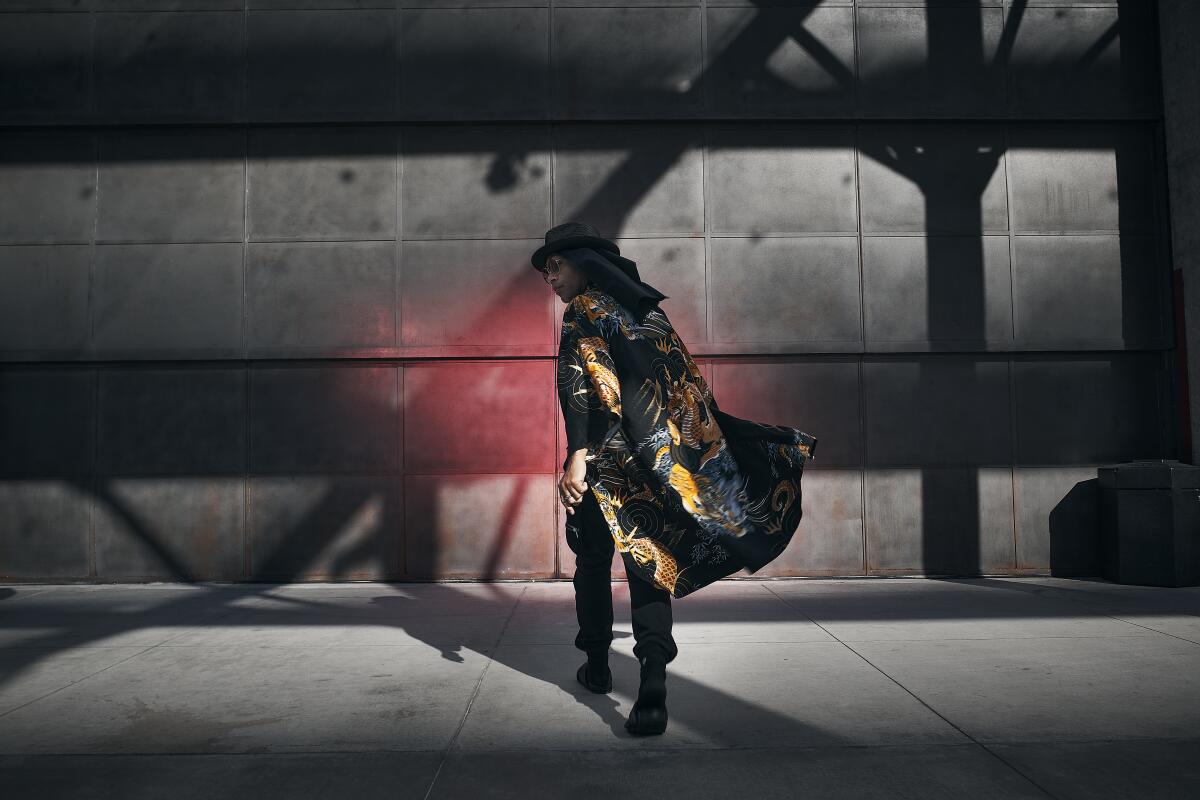
MOCA’s Little Tokyo location is a stone’s throw from Exchange L.A., an EDM-leaning club with the occasional techno booking, and 1720, a warehouse-style multigenre space. It’s eight miles from Sound, a popular club that books techno DJs. But local lovers of the genre know the city’s offerings don’t end there. The underground scene predominantly happens in word-of-mouth warehouses that closely resemble the spirit of Craig’s “Party/After-Party.”
“Techno in L.A. is thriving. We turned a negative with the clubs closing so early into an absolute positive,” says Los Angeles native Michael Frazier, who DJs as Monsieur Frazier. “Our warehouse parties become places of refuge where you’re not constricted by the rules of the law.”
For Bahar Khadem, the San Fernando Valley native behind the warehouse party Direct Drive, techno parties being pushed to the edges of the city is a plus. “The cool thing about L.A.’s geographical makeup is that despite long distances between most destinations you travel to, L.A.’s nightlife scene is concentrated in the DTLA warehouse district, which makes party-hopping easily accessible,” she says.
Now that Low End Theory and the Airliner have closed, new hot spots like Hood Rave are attracting the attention of L.A.’s underground music scene.
The installation will be complemented by “Party/After-Party Sessions,” an event series at the Geffen Contemporary at MOCA thrown in collaboration with Los Angeles-based festival promoters Insomniac and Secret Project. Featured artists include DJ Holographic, Moritz von Oswald, King Britt and Craig.
Those with mileage on the dance floor will identify Easter eggs satirizing typical cues DJs might throw at impatient audiences (air horn, anyone?). But whether or not visitors have ever been to a warehouse party, Craig wants people to abandon their expectations of him as a DJ when experiencing “Party/After-Party.” “People want to be able to throw their hands in the air,” he says, “They want to have the sort of typical club feeling and I don’t want things to be typical in that way with how people experience ‘Party/After-Party.’
“My career has always been about stepping out of the box,” he adds. “If a risk doesn’t work, then I try another until it does. This has really helped to push my legacy forward as not only a musician but as an all-around artist.”
'Carl Craig: Party/After-Party'
Where: The Geffen Contemporary at MOCA, 152 N. Central Ave., Los Angeles
When: 11 a.m.-5 p.m. Tuesday-Wednesday, 11 a.m.-8 p.m. Thursday, 11 a.m.-5 p.m. Friday, 11 a.m.-6 p.m. Saturday-Sunday. Runs April 16-July 23.
Info: moca.org/visit/geffen-contemporary
Lina Abascal is a culture writer born and raised in Los Angeles. She is the author of the nonfiction music book “Never Be Alone Again: How Bloghouse United the Internet and the Dancefloor.” A product of the California public school system, she received her bachelors in journalism from San Francisco State University and MFA in creative writing from California State University Long Beach.
More to Read
The biggest entertainment stories
Get our big stories about Hollywood, film, television, music, arts, culture and more right in your inbox as soon as they publish.
You may occasionally receive promotional content from the Los Angeles Times.
